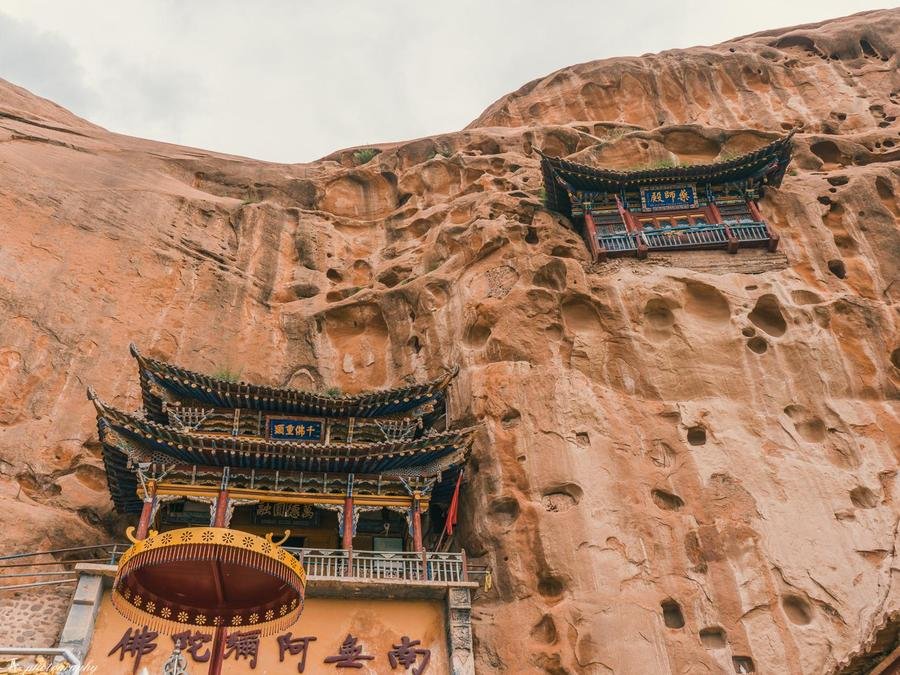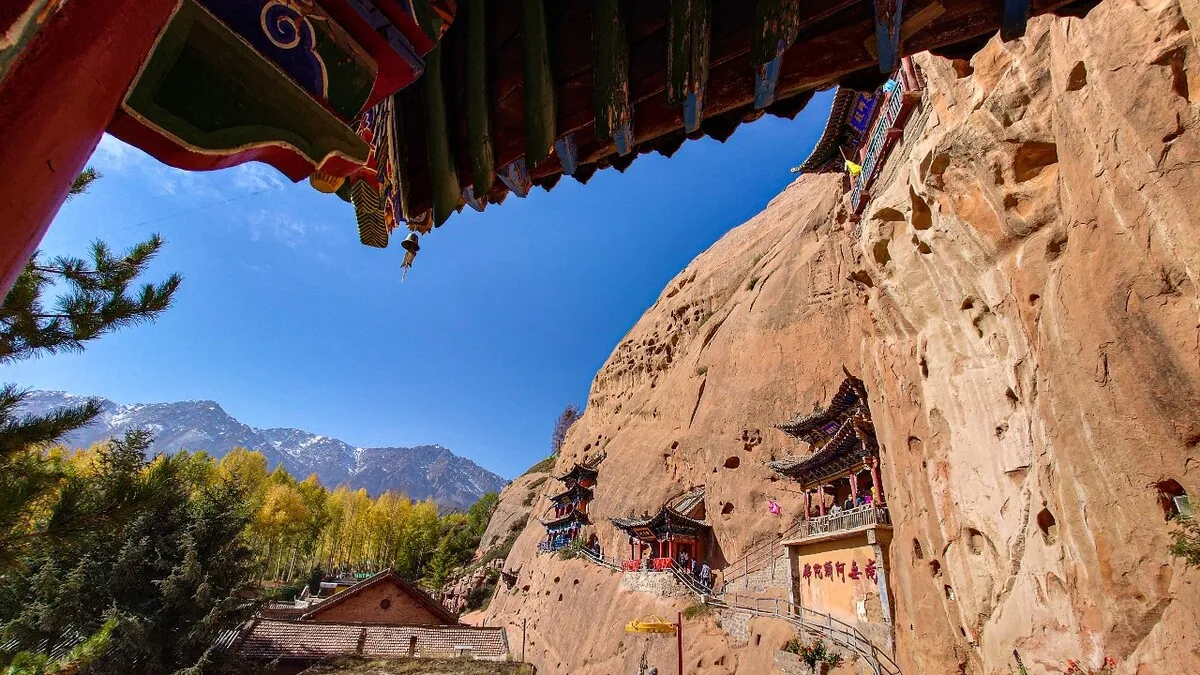Mati Temple (马蹄寺, Matisi Temple), located in Zhangye City, Gansu Province, China, is a renowned tourist destination blending cave art, the scenic beauty of the Qilian Mountains, and Tibetan cultural elements. Legend has it that a celestial horse once descended to earth, imprinting its hoof onto a rock here, thus giving the temple its name, which translates to “Horseshoe Temple.”
Originally established during the Northern Liang period, Mati Temple began as a Han Buddhist monastery and later evolved into a Tibetan Buddhist temple. Its caves, dating back to the Northern Liang Dynasty, include prominent sites such as Shengguo Temple, Puguang Temple, Qianfo Cave, Jinta Temple, and Upper, Middle, and Lower Guanyin Caves, totaling over 70 grottoes spread across nearly 30 kilometers. The earliest caves were carved during the Jin Dynasty by Guo Yu and his disciples, initially serving as a secluded place for study and later adorned with Buddha statues. At its peak, Mati Temple housed over three hundred monks.
Renowned for its historical significance, Mati Temple’s caves are celebrated alongside the Mogao Caves in Dunhuang and the Yulin Caves in Anxi as one of the three great art treasure troves of Hexi (west of the Yellow River) Buddhism. The temple’s main attractions include the Qianfodong (Thousand Buddha Cave), Jinta Temple (Gold Pagoda Temple) and the Thirty-Three Heavens Buddha Cave. The latter, a seven-tiered, stair-stepped structure carved into the mountainside, features numerous ancient Buddha statues. Visitors to Mati Temple can also experience the unique lifestyle of the Yugur ethnic minority by staying in their traditional tents, enjoying barley wine, and savoring hand-grabbed meat, offering a glimpse into the nomadic culture of the grasslands.
Table of Contents
- Basic Information
- Location and Transportation
- Highlights of Mati Temple Caves
- Vlog about Mati Temple
- Other Attractions in Zhangye Outskirts
Basic Information
| Estimated Length of Tour | 2 hours |
| Ticket Price | 65 RMB (1st April – 31st October) 56 RMB (1st November – 31st March) |
| Opening Hours | 8.30 – 18.00 |
| Telephone Number | 0086-0936-8891646 0086-0936-8891610 |
Location and Transportation
Mati Temple is located in Mati Tibetan Township, Sunan Yugu Autonomous County, Zhangye City, Gansu Province, China. Situated about 65 kilometers north of Zhangye’s city center, , this historic temple complex is nestled in a picturesque setting at the foothills of the Qilian Mountains.
To reach Mati Temple from Zhangye City, you can take a dedicated tourist bus service from Zhangye South Bus Station. The bus ride takes approximately 1 to 2 hours and provides convenient access to the temple complex.
| Transportation | Tourist Bus from Zhangye South Bus Station |
| Bus Schedule | 7:25 AM, 8:25 AM, 9:25 AM, 4:30 PM |
| Ticket Price | 13 CNY one-way (round-trip tickets available) |
| Return Bus | Last bus departs at 4:30 PM |
| Key Stops | Thirty-Three Heavens Cave, Thousand Buddha Caves |
Highlights of Mati Temple Caves
Qianfodong (Thousand Buddha Cave)

Qianfodong, located at the eastern cliff entrance of Mati Mountain, features numerous niches carved into the cliffs, dating back to the Northern Liang Dynasty. Divided naturally into southern, central, and northern sections, this complex includes a notable array of stone pagodas known locally for their intricate craftsmanship. These pagodas typically consist of bases, shafts, circumferential wheels, disc-like platforms, and spires, exemplifying the region’s distinctive cave artistry.
Among the prominent caves within Qianfodong is Cave No. 6, also known as the Western Trinity Hall, carved during the prosperous Tang Dynasty. Adorned with flying eaves and winged corners, this cave hosts rock-carved statues that, despite some damage, retain their full-faced features, well-proportioned bodies, and lively poses typical of the Tang artistic style.
Cave No. 8, dating to the Northern Liang period, is notable for its depth and dimensions, featuring a central pillar with five-tiered niches on the southeast and southwest walls. These niches once housed statues of Buddhas and attendant bodhisattvas, with early murals above depicting scenes of Shakyamuni Buddha and Maitreya Bodhisattva, showcasing artwork from the Northern Wei period.
Jintasi (Golden Pagoda Temple)

Jintasi, located on the western bank of Daduma River, deep within a valley known as Cigou, boasts cave temples carved into cliffs approximately 60 meters above ground level. Accessible via a steep 211-step stone staircase, these caves are oriented north to south and are predominantly attributed to the Northern Wei Dynasty based on their architectural features, sculptures, and mural styles.
The eastern cave of Jintasi is particularly renowned for its large scale and high artistic value. The cave, approximately six meters deep, features a central square-shaped pillar that extends to the cave roof, occupying much of the cave’s volume. Surrounding this pillar are niches housing Buddha statues, adorned with vividly colored flying apsaras (celestial beings) and bodhisattvas in the act of offering, depicted in three-dimensional relief. These sculptures are notable for their robust physique, natural and expressive facial features, and graceful postures, showcasing exceptional creativity and imaginative prowess in ancient Chinese cave art.
Puguang Temple (Northern Temple)

Mati Temple is divided into two main sections: the Southern Temple and the Northern Temple. While the Southern Temple, also known as Shengguang Temple, features fewer preserved niches and focuses on relief sculptures and Lama-style pagodas, the Northern Temple is renowned for its extensive collection of caves and impressive architectural features.
Among the highlights of the Northern Temple is Cave No. 3, known as the “Thirty-Three Heavens Cave.” This cave is the largest and most structurally unique in the Northern Temple complex. Carved into the cliff face, Cave No. 3 is arranged in a distinctive five-tiered layout that resembles a towering pagoda. The cave’s design includes a series of interconnected chambers, each representing different levels of the temple.
On the lower three tiers of the cave, there are five Buddha niches on each level, displaying detailed and vibrant sculptures of various Buddhist figures. The fourth tier features three additional caves, while the topmost level contains a single, prominent cave. The interior of Cave No. 3 is adorned with intricate carvings and murals, showcasing thousands of Buddha images and elaborate Buddhist iconography.






Mati Temple is the farthest scenic spot from the city center, and I signed up for a half-day tour. The Qilian Mountains are truly beautiful, and the caves are magnificent. I climbed up to the Hall of the Medicine Buddha but almost couldn’t make it down, so I decided to give it up. I didn’t visit the special caves numbered 1 to 4.
Ma Ti Temple is definitely worth a visit! Our original plan was to go to Mount Balas, but it would take a whole day to travel back and forth, so we ultimately decided on Ma Ti Temple. The snow was very thick, even denser than the snow at the Grand Canyon, and we had a fantastic time. Climbing the Thirty-Three Caves was actually not too difficult when using both my hands and feet!
We set off at 7:30 AM and arrived at the Thousand Buddha Caves. We were unsure if we could access the Medicine Master Hall due to the narrow and dark ascent, so we decided to skip it. Next, we reached the Thirty-Three Heavens, which was both fascinating and tiring. The view of the snow-capped mountains from the caves was beautiful. We then arrived at special Caves 1-4, a small attraction that we completed in just about ten minutes. Around 11:20… Read more »
The biggest surprise in Zhangye was seeing the snow-capped mountains. The Qilian Mountains were stunning and breathtaking. The visual impact of the red wishing bridge at the entrance of Maji Temple against the backdrop of the pure white snow was simply beautiful.
After about an hour’s drive from Zhangye, I arrived at my destination. The scenery along the way was already breathtaking, with poplar forests lining the roadside and little lambs crossing the road from time to time. Every scene was unforgettable. However, it was only when I reached the entrance of Mati Temple that I truly experienced a place that was breathtaking: snow-capped mountains, falling leaves, and temples—all the dreamlike scenes came to life here!
When visiting Zhangye, you must go to Mati Temple. Not only can you see the cave temples, but there are also stunning mountains and vast grasslands. Along the way, you’ll encounter numerous cattle, sheep, and horses – it’s truly a dual enjoyment of culture and scenery.